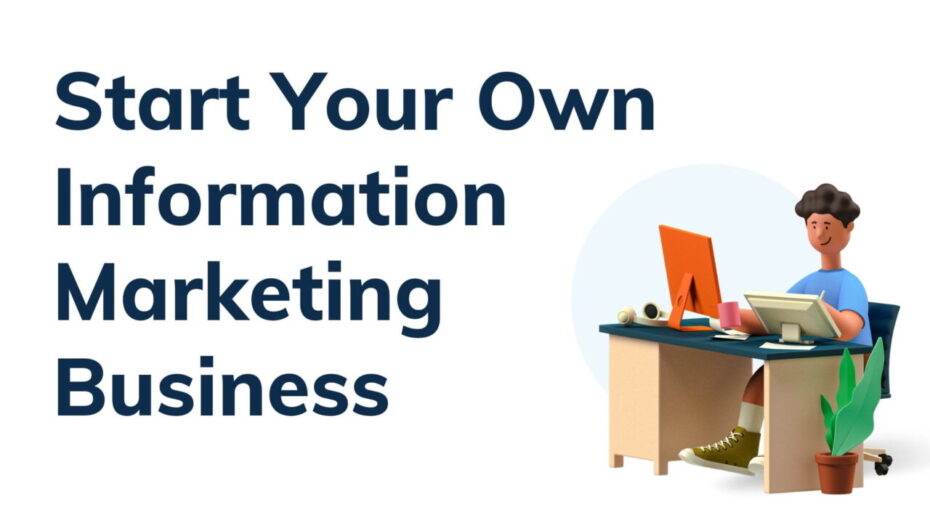Are you contemplating the leap into the world of information marketing? Wondering if this could be the key to unlocking your entrepreneurial potential? Information marketing is an expansive field that allows you to capitalize on knowledge and expertise in various niches.
From my perspective, starting your own information marketing business is not just about selling information—it’s about transforming your unique insights into valuable resources that solve real problems.
In this article, I’ll guide you through the essential steps and strategies to establish, grow, and scale your information marketing business. I believe that with the right approach, this venture can not only be lucrative but also deeply rewarding. Let’s dive into the best tips to get your business off the ground with a solid foundation.
Table of Contents
Unleashing the Potential of Information Marketing
Information marketing isn’t just about pushing content; it’s about creating value in a way that resonates with your audience. I believe that understanding the profound impact of quality information can transform how we approach this business model. In this digital age, information is more than just data—it’s a tool that empowers consumers and creates opportunities for savvy entrepreneurs.
I recommend delving deep into the dynamics of this market. Information marketing allows for a diverse range of products, from ebooks and courses to webinars and workshops. Each format caters to different learning styles and preferences, providing multiple revenue streams for your business. By aligning your content with the needs and wants of your target market, you can maximize both reach and impact.
My suggestion for those starting in this field is to focus on the scalability of your efforts. As your business grows, so too should your strategies for content creation and distribution. Leveraging automation tools and platforms can help manage and expand your operations efficiently, ensuring that your business can thrive without being overwhelmed by its own success.
Understanding What Information Marketing Really Entails
From my perspective, information marketing is fundamentally about educating your audience. It’s not merely selling information; it’s about packaging your knowledge in a way that is accessible and useful to others. This requires a deep understanding of who your audience is and what they seek to learn, making your information not just heard, but also applied.
I strongly believe that the key to success in this field is relevance. Your information must address current trends and pain points, offering solutions that are immediately applicable. This might involve conducting thorough market research or engaging with your audience to gain firsthand insights into their challenges and needs.
In my opinion, another crucial aspect is the delivery method. Whether it’s through detailed guides, interactive courses, or concise tips, the way you present your information can significantly affect its effectiveness. Choosing the right platforms and tools to reach your audience where they are most active is essential for engagement and retention.
Why Information Marketing Could Be Your Best Venture Yet
I am of the view that information marketing offers unparalleled flexibility and potential for innovation. With the digital world at your fingertips, there are countless ways to craft and distribute your content. This sector allows creative freedom that many other business models cannot match, enabling you to truly make your mark and stand out.
My advice to potential entrepreneurs is to leverage this flexibility to experiment with different content types and marketing strategies. This approach will help you discover what resonates best with your audience and can lead to more effective and personalized marketing efforts.
I assume that if you’re considering this path, you’re likely driven by a passion for sharing knowledge. This is a powerful motivator and can be your greatest asset. Enthusiasm is contagious, and when coupled with strategic business practices, it can transform your information into a compelling product that captivates and educates.
I couldn’t agree more with the sentiment that starting an information marketing business is not just about financial gain. It’s about making a positive impact by sharing valuable knowledge. This can create a fulfilling cycle of learning and growth for both you and your audience, making it one of the most rewarding ventures you could embark on.
Essential First Steps to Establish Your Information Business
Starting an information marketing business requires a well-thought-out strategy. First and foremost, it’s crucial to establish a clear vision of what you aim to achieve. From my point of view, setting concrete goals will guide your efforts and help measure your progress.
Begin by defining the scope of your information products and services, ensuring they align with your expertise and the needs of your potential customers.
Next, I suggest focusing on your business structure. Choose a business model that supports scalability and flexibility. Whether it’s a sole proprietorship or a partnership, the right structure will impact your operational efficiency and tax liabilities. My advice is to consult with a business advisor or attorney to make informed decisions that suit your long-term objectives.
Lastly, it’s important to set up your business legally. Registering your business and obtaining the necessary licenses will not only legitimize your operations but also protect your brand and content. I strongly believe that taking these legal steps seriously can save you from potential issues down the road, allowing you to focus more on growing your business.
Deciding Your Niche: Tailoring Content That Sells
Choosing the right niche is critical in the information marketing industry. I recommend selecting a niche that not only interests you but also has a significant demand. This ensures that your content will engage a specific audience that is eager for the information you provide. Conducting thorough market research can help identify these opportunities.
Once you’ve identified your niche, my suggestion is to deeply understand your audience’s preferences and pain points. This knowledge allows you to create tailored content that addresses their specific needs and challenges. From my perspective, content that solves problems or enhances skills is particularly effective in attracting and retaining customers.
Creating a content strategy that aligns with your audience’s learning preferences is also crucial. Whether they prefer visual infographics, in-depth articles, or interactive webinars, your content delivery should match their consumption habits. I believe that this approach not only improves engagement but also boosts the perceived value of your information.
Building a Robust Business Model for Sustained Success
Building a robust business model involves more than just content creation. From my point of view, it requires a dynamic approach to revenue generation. Consider diverse income streams such as subscriptions, one-time sales, and affiliate marketing. This diversity can help stabilize your income and reduce reliance on a single revenue source.
In addition to revenue diversification, I strongly believe in the importance of building a resilient marketing strategy. Utilize both organic and paid marketing tactics to reach a broader audience. SEO, social media marketing, and email campaigns are crucial for driving traffic and conversions.
Finally, I recommend establishing strong customer relationships. Providing exceptional customer service and regular updates can create loyal customers and encourage referrals. My advice is to leverage customer feedback to continually improve your products and services. This not only enhances customer satisfaction but also contributes to your business’s long-term success.
Crafting Your Information Product – Tips and Strategies
Creating a compelling information product requires careful planning and execution. My advice is to start by defining the core message and learning outcomes of your product. This clarity will guide you in structuring content that is both informative and engaging. Ensure each module or chapter builds on the previous one, facilitating a seamless learning experience for your audience.
Next, I recommend focusing on the format and presentation of your information. Whether it’s an e-book, video series, or online course, the format should cater to the learning preferences of your target audience. From my point of view, diverse formats can help accommodate different learning styles, increasing the overall effectiveness of your product.
Finally, I think it’s crucial to ensure your content is accessible. This means designing your products to be easily navigable and user-friendly, regardless of the user’s tech savviness. Using clear language, logical content organization, and interactive elements can greatly enhance the user experience, making your information product more appealing and useful.
Designing Engaging and Valuable Content
To design content that truly engages and adds value, my recommendation is to start with thorough research. Understand what content already exists and how your product can offer something unique. This insight will help you create content that stands out and addresses gaps in the market.
In my opinion, storytelling can be a powerful technique to make your content more relatable and memorable. Weave relevant stories or case studies into your content to illustrate key points and keep your audience engaged. This approach can transform abstract concepts into tangible learning that resonates with your audience.
I also suggest incorporating interactive elements such as quizzes, assignments, and discussion prompts. These interactions encourage active participation, reinforcing learning and making the experience more dynamic. According to educational research, interactive content can significantly improve retention and satisfaction rates.
In terms of content design, it’s important to maintain a consistent and professional look across all your materials. This includes using a harmonious color scheme, high-quality images, and a clean layout. My impression is that visually appealing content not only attracts attention but also enhances the perceived value of your information product.
Tools and Technologies to Enhance Product Creation
Choosing the right tools and technologies is crucial for efficient and effective product creation. I strongly believe that investing in a robust content management system (CMS) can streamline your content creation and maintenance processes. A good CMS will allow you to organize your content efficiently, manage updates, and scale your offerings as your business grows.
Another essential tool is a reliable video hosting platform if your product includes video content. I recommend platforms that offer high-quality streaming, interactive features, and strong analytics. These features can enhance the learning experience and provide you with valuable insights into how your content is consumed.
For interactive and multimedia content, tools like interactive video software and e-learning authoring tools can be invaluable. These technologies enable you to create dynamic educational experiences that can keep your audience engaged and facilitate deeper learning.
Lastly, I suggest integrating feedback mechanisms into your product. Tools that allow you to gather and analyze user feedback can help you understand what works and what needs improvement. This ongoing feedback loop is vital for continuously refining your product and ensuring it meets the needs of your audience effectively.
Marketing Strategies That Amplify Your Reach
Effective marketing is crucial for the success of your information marketing business. In my opinion, a well-rounded marketing strategy should integrate both digital and traditional methods to maximize your reach. Start by identifying the channels where your target audience is most active. This tailored approach ensures that your marketing efforts are focused and efficient, yielding better results in terms of engagement and conversions.
Next, I recommend developing compelling marketing messages that clearly communicate the value of your information products. This involves highlighting the unique benefits and results that your content can deliver. From my perspective, clear and persuasive messaging is key to capturing the attention of potential customers and persuading them to take action.
Finally, it’s important to track and analyze the effectiveness of your marketing strategies. I suggest using analytics tools to monitor key metrics like click-through rates, engagement levels, and conversion rates. This data will provide valuable insights that can help you refine your marketing tactics over time, ensuring that they remain effective as market dynamics evolve.
Leveraging Social Media for Effective Promotion
Social media is a powerful tool for promoting your information products. I believe that the first step is to choose the right platforms based on where your target audience spends their time. For example, if your content is highly visual, platforms like Instagram and Pinterest might be more effective. Alternatively, for B2B marketing, LinkedIn could be more suitable.
Once you’ve identified the appropriate platforms, I recommend creating engaging content that resonates with your audience. This could include behind-the-scenes looks, customer testimonials, and informative posts that highlight the practical applications of your information. From my experience, content that educates or entertains tends to perform well on social media.
It’s also crucial to engage actively with your followers. Responding to comments, participating in discussions, and sharing user-generated content can build a community around your brand. I strongly believe that an active and engaged social media presence can enhance your brand’s visibility and credibility, driving more traffic to your products.
To maximize the impact of your social media efforts, I suggest using paid advertising to reach a broader audience. Targeted ads can help you reach potential customers who may not yet be aware of your brand but have shown interest in similar content. According to industry experts, combining organic efforts with paid campaigns can significantly increase your reach and conversion rates.
SEO Tactics to Rank Higher in Information Marketing
SEO is essential for increasing the visibility of your information marketing business online. I recommend starting with keyword research to identify terms that your target audience is searching for. This insight will guide your content creation, ensuring that it aligns with user intent and search demand.
Building high-quality backlinks is another important SEO strategy. I suggest guest posting on reputable sites in your industry or collaborating with influencers. These links can drive direct traffic and improve your site’s authority, which is critical for SEO. From my perspective, the quality of backlinks often outweighs quantity, so focus on forming meaningful partnerships.
On-page optimization is also crucial. Ensure that your website’s structure, meta tags, and content are optimized for both search engines and users. This includes using headers effectively, optimizing images, and ensuring that your website is mobile-friendly. I believe that a well-optimized site not only ranks better but also provides a better user experience, which can lead to higher engagement and conversions.
Lastly, I recommend regularly updating your content to keep it relevant and fresh. Search engines favor websites that consistently provide up-to-date and valuable information. My advice is to review and update your articles and posts periodically, adding new insights and information as your industry evolves. This not only helps with SEO but also reinforces your position as a thought leader in information marketing.
Sales Funnel Optimization for Information Marketers
Optimizing your sales funnel is crucial for converting interest into sales in the field of information marketing. My first suggestion is to understand each stage of your funnel, from awareness to purchase, and ensure that it’s tailored to guide prospects smoothly towards buying. Use analytics to identify where prospects drop off and test changes to improve these areas.
Next, I recommend developing targeted content that addresses potential customers at different stages of their buyer’s journey. From educational articles that raise awareness to comparison guides that help in the decision-making process, each piece should be designed to move the prospect to the next stage.
Finally, it’s essential to streamline the purchase process. I believe that a simple, hassle-free checkout experience can significantly increase conversion rates. Ensure that your website is optimized for fast loading times, and the checkout process is straightforward with multiple payment options. This not only enhances user experience but also builds trust and reduces cart abandonment.
Capturing Leads: Strategies That Convert Visitors to Customers
Capturing leads effectively is about enticing visitors with compelling offers they can’t ignore. I would say that creating high-value lead magnets like free ebooks, webinars, or trial subscriptions can be highly effective. Ensure these offers are relevant to your target audience’s needs and provide genuine value, which can increase the likelihood of conversion.
From my perspective, optimizing landing pages is also critical for lead capture. These should be designed with a clear focus on encouraging sign-ups, featuring strong, persuasive copy and a simple, clutter-free layout. Utilizing A/B testing to refine your landing pages can lead to better results, helping you understand what resonates best with your audience.
I strongly believe in the power of social proof to enhance lead capture. Including testimonials, user reviews, and case studies on your landing pages can significantly boost credibility and convince potential leads of the value of your offer. Make sure these elements are visible and reflect the positive experiences of your users.
According to best practices, it’s also vital to use a call to action (CTA) that stands out and is direct about what you want the visitor to do. Whether it’s to download, sign up, or get more information, make your CTAs clear and compelling.
Nurturing Leads: How to Keep Your Audience Engaged
Once leads are captured, nurturing them is key to converting them into paying customers. My advice is to employ an email marketing strategy that delivers regular, valuable content directly to their inboxes. This could include tips, industry insights, or updates about your products. Personalize these communications as much as possible to build a stronger connection with your audience.
I also recommend leveraging retargeting strategies to remain visible to those who have shown interest but haven’t yet purchased. By displaying relevant ads across different platforms, you can keep your brand at the forefront of their minds and gently guide them back to your sales funnel.
From my experience, engagement can be significantly increased by interactive content such as quizzes, surveys, or interactive videos. These tools not only entertain and engage but also gather additional insights about your leads, which can be used to further personalize your marketing efforts.
Lastly, I am of the mind that consistency in follow-up is crucial. Don’t let your leads go cold. Keep the communication frequent enough to stay relevant but not so much that it becomes intrusive. I believe this balanced approach is key to keeping your leads engaged and moving them towards a purchase.
Scaling Your Information Marketing Business
Scaling your information marketing business is a crucial step towards long-term success and sustainability. First, I recommend assessing your current business model to identify areas that can handle and benefit from expansion. It’s important to ensure that the foundation of your business is solid before adding more complexity. From my experience, scaling too quickly without proper infrastructure can lead to operational inefficiencies.
Next, consider diversifying your product offerings. This could mean introducing new topics, formats, or advanced-level content to cater to different segments of your audience. I believe that diversification not only broadens your market reach but also enhances the resilience of your business against market fluctuations.
Finally, technology plays a significant role in scaling any digital business. Investing in scalable technologies such as cloud services, advanced marketing automation tools, and customer relationship management systems can greatly increase your operational capacity. My advice is to choose technologies that integrate well with your existing setup to ensure a smooth transition.
Expanding Your Product Line: When and How
When considering expanding your product line, timing and strategy are key. I recommend analyzing market trends and customer feedback to determine the right time to introduce new products. This insight will help you identify gaps in the market and areas of high demand. Launching new products that align with these insights can significantly increase your chances of success.
In terms of how to expand, I suggest starting small with a pilot project or limited release to test the market’s response. This approach allows you to gather valuable feedback and make necessary adjustments before a full-scale launch. From my perspective, it also mitigates risk by not overcommitting resources initially.
I strongly believe in the importance of maintaining quality as you expand. Your new offerings should meet or exceed the standard of your existing products. This consistency in quality helps maintain your brand’s reputation and trust with your audience. My advice is to invest in skilled resources and quality assurance processes to uphold high standards.
Most importantly, consider the scalability of your new products. They should be designed not just for current demand but with the potential for future expansion. This could involve modular content that can be easily updated or extended, or evergreen content that remains relevant over time.
Collaborations and Partnerships: Growing Through Synergy
Collaborations and partnerships can be incredibly effective for scaling your business. By aligning with other businesses or influencers in your industry, you can leverage their audiences and resources for mutual benefit. I recommend selecting partners whose offerings complement rather than compete with yours. This synergy can lead to more comprehensive solutions for your customers.
Engaging in partnerships also allows for knowledge sharing and innovation, which can enhance your own product offerings and marketing strategies. From my perspective, these collaborations should be based on transparency and shared goals to ensure long-term success. It’s essential to clearly define roles, expectations, and contributions from the beginning.
I believe that partnerships should also focus on co-marketing efforts. Joint webinars, co-authored content, and shared social media campaigns are examples of how you can effectively market together. This not only increases your reach but also adds value to your audience by providing varied perspectives and expertise.
Lastly, my suggestion is to formalize partnerships with contracts that outline terms and conditions clearly. This helps prevent misunderstandings and ensures that both parties are committed to the partnership’s success. Regularly revisiting and revising the partnership terms can also help adapt to any changes in business objectives or market conditions.






